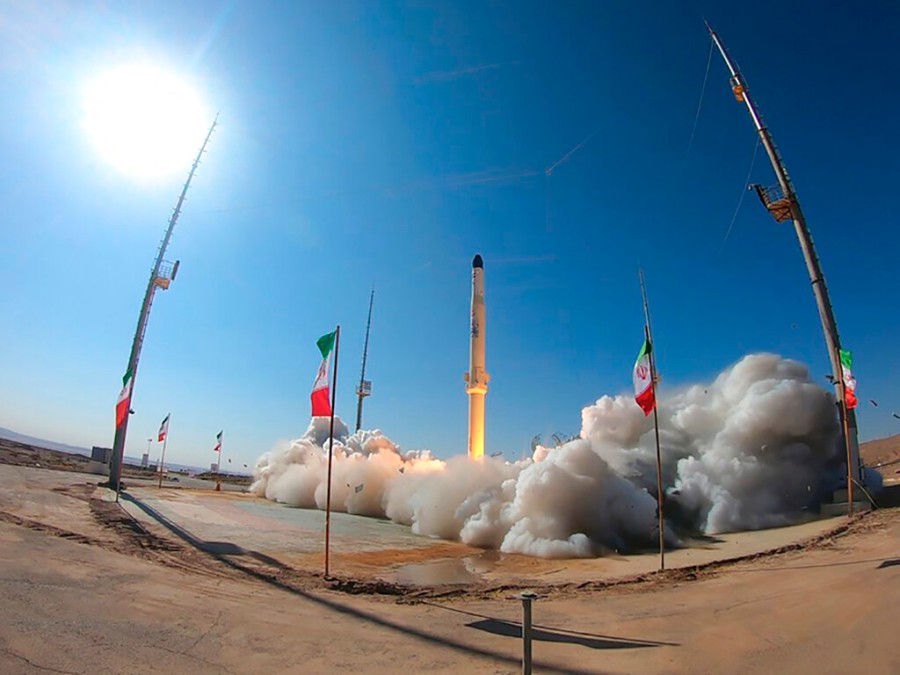February 26, 2021

The Pasdaran have test launched yet another missile intended to put satellites into orbit.
The Pasdaran said the test of the Zoljannah was successful. The launch was a test of the missile and did not attempt to put a satellite into orbit, they said.
This is the second new type of satellite launcher fired into space in the last year. The other was also launched by the Pasdaran—putting that military force firmly in the lead in Iran’s supposedly-civilian space program.
The civilian program has two rockets. The Safir has successfully put the first four of Iran’s satellites into orbit. But all were in such bad orbits that they fell out of orbit and burned up. None lasted even 90 days.
The other civilian rocket is the much-larger Simorgh, which has never succeeded in placing a satellite into orbit.
The Pasdaran’s first satellite launcher, the Qased (Messenger), succeeded in putting the Nur satellite into orbit last April. But from the first day, the satellite was tumbling and thus could not function. It is still in orbit, albeit useless.
The Zoljannah comes is three stages, according to the Pasdaran. The first two are powered by solid fuel and the top stage is powered by liquid fuel. This makes Western analysts very suspicious. Satellite rockets are normally powered by liquid fuel. The downside is that it takes hours to prepare the rocket for launch. That doesn’t matter for a satellite launch. But it is a major downside for a military missile. In the hours a military missile is being fueled, the enemy could locate it and destroy it.
The Pasdaran also said the Zoljannah can be fired from a mobile launch pad, another signal that disturbed Western analysts. There is no need for space launch vehicles to be mobile, while military missiles can better evade detection by being loaded on trucks.
The Pasdaran said the solid-fueled rocket engine used on the Zoljannah is the most powerful rocket engine yet made in Iran. That was another source of unease among Western analysts, who wondered if the regime was aiming for a missile that could fly further than the 2,000-kilometer range of Iran’s current military rockets.
Jeffrey Lewis, an arms control specialist at the Middlebury Institute of International Studies in California, estimated that, if the Zuljannah were launched at an angle to seek distance rather than straight vertically to seek height, it could carry a one-ton warhead up to 3,100 miles (5,000 kilometers). That would allow it to cover much of the Eastern Hemisphere, but not to reach the Western Hemisphere.
The Pasdaran said the Zoljannah named after the horse of Imam Hussein weighs 52 tons and stands 25.5 meters (85 feet) high, making it
The Pasdaran said the Zoljannah can carry satellites:
- Weighing up to 220 kilos (485 pounds) or 2-1/2 times heavier than any satellite thus far orbited by Iran, although that is still very small in this age of multi-ton satellites;
- To an altitude of 500 kilometers, which is just a little higher than the 440-kilometer altitude of the satellite put in orbit a year ago by the Qased rocket.
Meanwhile, Fathollah Ommi, head of the Aerospace Research Institute, said Iran now plans to put a human into orbit by 2031. President Mahmud Ahmadi-nejad originally set a goal of orbiting a man by 2019. That was later changed to 2025. President Rohani then tried to kill the entire program. But it has now been resumed with a 2031 goal.
So far, only three countries have orbited human beings: the Soviet Union/Russia, the United Stages, and China, although private American firms are now testing designs for human flight.
